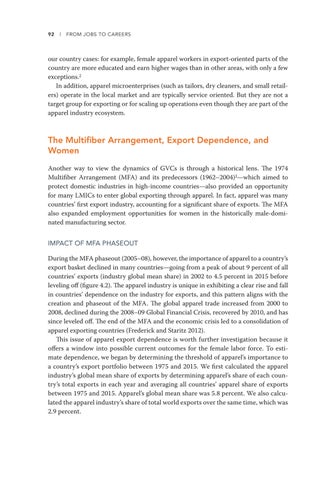92
l
FROM JOBS TO CAREERS
our country cases: for example, female apparel workers in export-oriented parts of the country are more educated and earn higher wages than in other areas, with only a few exceptions.2 In addition, apparel microenterprises (such as tailors, dry cleaners, and small retailers) operate in the local market and are typically service oriented. But they are not a target group for exporting or for scaling up operations even though they are part of the apparel industry ecosystem.
The Multifiber Arrangement, Export Dependence, and Women Another way to view the dynamics of GVCs is through a historical lens. The 1974 Multifiber Arrangement (MFA) and its predecessors (1962–2004)3—which aimed to protect domestic industries in high-income countries—also provided an opportunity for many LMICs to enter global exporting through apparel. In fact, apparel was many countries’ first export industry, accounting for a significant share of exports. The MFA also expanded employment opportunities for women in the historically male-dominated manufacturing sector. IMPACT OF MFA PHASEOUT During the MFA phaseout (2005–08), however, the importance of apparel to a country’s export basket declined in many countries—going from a peak of about 9 percent of all countries’ exports (industry global mean share) in 2002 to 4.5 percent in 2015 before leveling off (figure 4.2). The apparel industry is unique in exhibiting a clear rise and fall in countries’ dependence on the industry for exports, and this pattern aligns with the creation and phaseout of the MFA. The global apparel trade increased from 2000 to 2008, declined during the 2008–09 Global Financial Crisis, recovered by 2010, and has since leveled off. The end of the MFA and the economic crisis led to a consolidation of apparel exporting countries (Frederick and Staritz 2012). This issue of apparel export dependence is worth further investigation because it offers a window into possible current outcomes for the female labor force. To estimate dependence, we began by determining the threshold of apparel’s importance to a country’s export portfolio between 1975 and 2015. We first calculated the apparel industry’s global mean share of exports by determining apparel’s share of each country’s total exports in each year and averaging all countries’ apparel share of exports between 1975 and 2015. Apparel’s global mean share was 5.8 percent. We also calculated the apparel industry’s share of total world exports over the same time, which was 2.9 percent.


